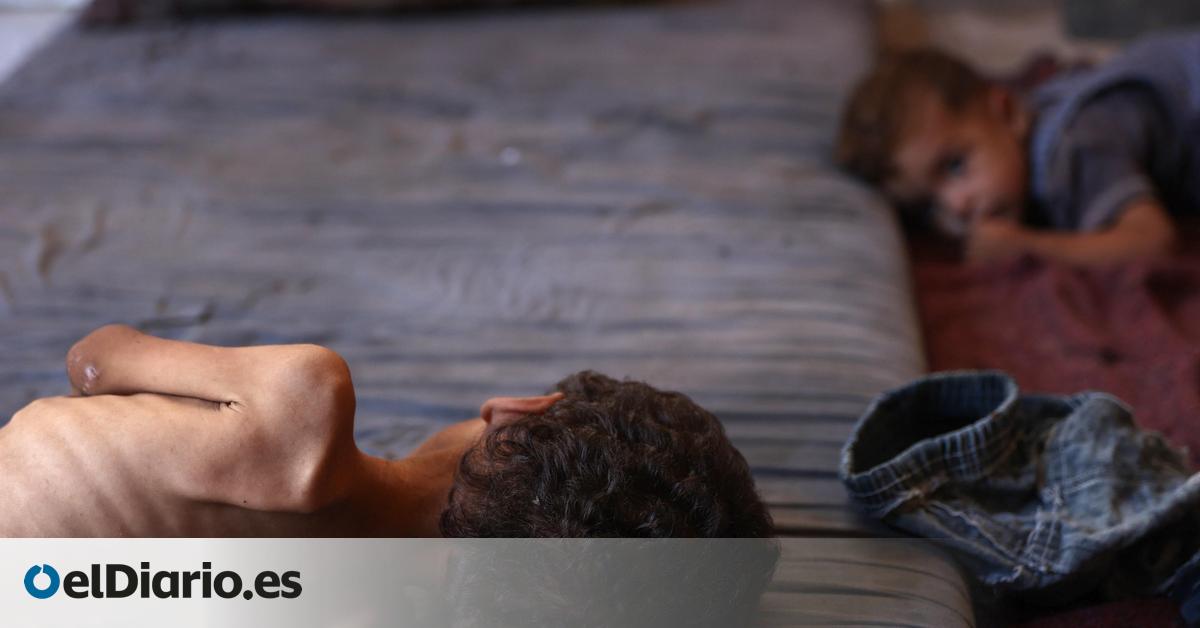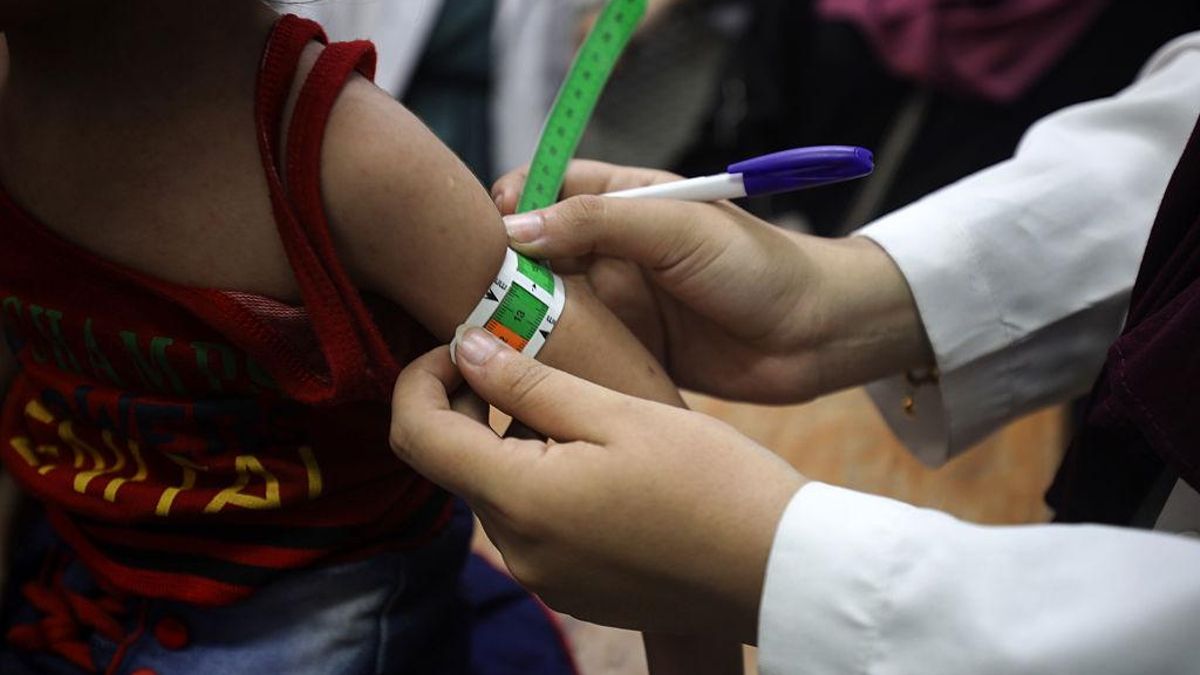
“My eldest daughter is four years old. You should see her trying to load a drum, she is discouraging. He can’t.” Thus begins the story of a mother of Gaza, one more among many who reflect how the relentless hunger caused by the Israeli blockade is designated with the little ones. “There is nothing left; I can’t do anything,” he says, desperately in a testimony recently collected by doctors without borders (MSF), one of the NGOs that in precarious conditions continue to operate in the strip, where to help the Palestinian population is increasingly complicated.
While the hopes of a high fire fade after the stagnation of the negotiations, hunger continues to extend and charge lives in the Gazatí enclave. The bulk of the more than 100 people killed by this cause during the war were minor. Since April of this year, the number of children who have died for having nothing to take to their mouth has increased from 52 to 80, an increase of 54% in less than three months, according to the Palestinian Ministry of Health. The last deadly victim of the shortage of food and basic products was called Abdel Qader al Fayyumi, as reported by the Baptist Hospital to Ahli.
UN data suggests that malnutrition levels are significantly increasing among the little ones. During the first two weeks of July, collaborating organizations with the UN that work in food aid created 56,440 children to see if they were malnourished throughout the strip. Among them, 4,984 suffered acute malnutrition and 838 of these, in turn, presented a state of severe acute malnutrition. This is a reflection of a growing and worrying trend, according to the latest biweekly report of the United Nations Office for the Coordination of Humanitarian Affairs (Ocha).
The general rate of acute malnutrition among children examined rose from 2.4% in February 6% in June and 8.8% in July. Meanwhile, the severe acute malnutrition rate passed, in the same temporary intervals, from 1%to 1.5%, and then 2%, respectively.
The causes of child malnutrition are bad diet, lack of food and care, and limited access to water, health care and basic health conditions, which in the current context are seriously compromised, as the UN office recalls.
A malnourished child has 10 times more possibilities to die than a well fed one, but beyond that immediate risk, the consequences for survivors can prolong throughout their lives. Child malnutrition can hinder brain development, weaken the immune system, reduce the body’s ability to absorb nutrients and ballast cognitive and physical growth, with long -term consequences, explains the och.
The figures, increasing
As of July 20, they received treatment in stabilization centers in Ciudad de Gaza, deir Al Balah and Jan Yunis a total of 218 children with severe acute malnutrition, according to the Ocha. They are figures that worsen daily.
In Gaza City the situation is particularly alarming: of the 14,774 children screted in July, 16% suffered acute malnutrition (348 of them, in serious condition). The percentage is markedly higher than February, when the rate was 4%. The UN Agency for Palestinian refugees (UNRWA) has denounced this Thursday that one in five children suffers malnutrition in Gaza City, and cases increase every day.
The director of the UNRWA, Philippe Lazzarini, has warned that most children who attend their teams are “demacred, weak and run a high risk of dying if they do not receive the treatment they urgently need”. “Parents are too hungry to take care of their children,” he said, and has assured that those who arrive at their clinics “do not have energy, food or the means to follow medical advice.”
“For months, all the foundations have been generated for the situation that is occurring to occur,” says the person responsible for International Incidence of Save The Children, Arantxa Osés. “Humanitarian aid entry has been allowed with droppers; the access of this aid has been blocked; then it has been opened again; it has been blocked again and now we have a distribution system in which more than 1,000 people have already died,” he details.
The distribution system to which Osés is the one that since the end of May operates through the so -called Humanitarian Foundation of Gaza (GHF), an organization without prior experience, sponsored by Israel and the US and that distributes food in four centers that function as Atoles; There are dead “every day” among the gazaties who go to the points by shattered roads, flanked by tanks, soldiers and drones, according to Eldiario.es Aitor Zabalgogeazkoa, Emergency Coordinator of MSF in the Strip.
The humanitarian NGO has warned that severe malnutrition rates in children under five years have tripled only in the last two weeks. Last week, he made reviews in his centers and clinics to children between six months and five years old pregnant women and infants and 25% presented malnutrition. “It’s not just about hunger. This is deliberate and caused by Israeli authorities,” says MSF.

The Guardian He has compiled testimonies of desperate families for not being able to feed his children. A case that collects is that of Mohammed, a seven -month -old baby who weighs just four kilos and has already admitted twice at the hospital of the Patient’s Friends Benevolent Society, in Ciudad de Gaza.
“My greatest fear is that she dies malnourished,” says his grandmother Faiza Abdul Rahman, who in turn is always dizzy for eating little. “His brothers are also severe hunger and there are days when they go to bed without having eaten anything,” he laments.
Birth is also affected. The United Nations Population Fund reported last week that births have fallen 41 percentage points in Gaza in the first half of the year, compared to before the war. More than 20 children died before the first 24 hours after childbirth, and 33 of births were premature.
“What we have are conditions in which the immune systems of boys and girls subjected to these circumstances of deprivation, that is, not being able to access food, not being able to access drinking water, be surrounded by garbage, be overcrowded and not have adequate health services, because they have also been decimated, [nos han llevado a] A moment when the nut jumps, ”says Osés.
“The most difficult thing is when my daughter asks me to make a snack for the nursery and I don’t have bread,” says another of the mothers interviewed by MSF. The price of a kilo of bread has shot up to 100 dollars (85 euros), according to the United Nations Population Fund.
Malnutrition returns to children vulnerable to diseases, which is even more serious due to the shortage of medical supplies, which Israel blocks. “I can see that children would often survive if we die something so simple, but we don’t have it,” says Musab Farwana, pediatrician of the Patient’s Friends Benevolent Society, who tries to do everything possible to save their lives. Three children who were in intensive care died this week. One was a girl who had probably survived with a vein potassium injection. It is a basic treatment, but today almost impossible to obtain in Gaza.
“We tried with oral substitutes, but because of the complications of malnutrition, it could not absorb them,” he explains to the British newspaper. “These cases stick to me, I never took them out of my head. The girl could have returned with her family and lead a normal life, but for such a simple thing that was not available, she did not survive.”
The real number can be greater
“The number of boys and girls who have died from malnutrition in the hospital is 88, but there are many who are not getting hospitals, so this number can be much greater. And the rhythm is being increased,” Osés warns, which points out that the organization’s own staff suffers the lacks. “They are increasingly thin,” he says.
The entry into operation of the GHF mechanism has only aggravated the situation, says the person responsible for International Incidence of Save The Children. “I think it cannot only be attributed to that factor, but it has come to place on a context that has been deliberately reached and that the entities have been warning for a long time,” he says.
Umm Youssef al-Khalidi, mother of four girls and two boys, decided on Tuesday to try their luck in a GHF distribution center for the first time. So far he had avoided it because the little one is two years old and the oldest only 13, and her husband is in a wheelchair. “We have silenced hunger with water,” he says. “I fear more for my family than for me, because something bad happens to me and they stay with no one to attend them,” he says, and describes: “The children have stayed in the skeleton, they are only skin and bones. Everything tides them. They feel them, ask for food and have nothing to give them.”
Source: www.eldiario.es

